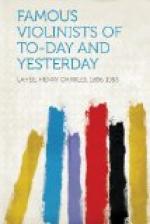His playing charmed and captivated the audience, although he was almost overcome with exhaustion. After taking some food and wine he appeared again, and this time he asked for a theme on which to improvise. He was given three, and, instead of making a selection, he took all three and interwove them in so brilliant a manner that he carried the audience by storm. He was at once engaged for the next concert, and made such success that he was accompanied to his hotel by a torchlight procession, and his carriage drawn home by the excited people.
Ole Bull continued his triumphant course through Italy. At Lucca he played at the duke’s residence, where the queen-dowager met with a surprise, as Ole refused to begin playing until she stopped talking. At Naples he experienced the misfortune of having his violin stolen, and he was obliged to buy a Nicholas Amati, for which he paid a very high price. After playing and making a great success in Rome, he returned to Paris, where he now found the doors of the Grand Opera open to him, and he gave several concerts there.
In 1836 he married Felicie Villernot, the granddaughter of the lady in whose house he had met with so much kindness during his first stay in Paris.
Following the advice of Rossini, he went to London, where he made his usual success, notwithstanding the intrigues of certain musicians, who endeavoured to discredit him. Such was his popularity in England that he received for one concert, at Liverpool, the sum of L800, and in sixteen months’ time he gave two hundred and seventy-four concerts in the United Kingdom.
He now decided to visit Germany, and on his way through Paris he made the acquaintance of Paganini, who greeted him with the utmost cordiality. He went through Germany giving many concerts, and visited Cassel, where he was now received by Spohr with every mark of distinction. He played in Berlin, where his success was great, notwithstanding some adverse criticism. He also played in Vienna and Buda-Pesth, and so on through Russia. At St. Petersburg he gave several concerts before audiences of five thousand people. He now went through Finland and so on to Sweden and Norway, where he was feted.
Although closely followed by Vieuxtemps and Artot, Ole Bull was the first celebrated violinist to visit America, and in 1843 he made his first trip, landing in Boston in November of that year and proceeding directly to New York, playing for the first time on Evacuation Day. “John Bull went out on this day,” he said, “and Ole Bull comes in.” He remained two years in the United States, during which time he played in two hundred concerts and met with many remarkable adventures. During his sojourn he wrote a piece called “Niagara,” which he played for the first time in New York, and which became very popular. He also wrote “The Solitude of the Prairies,” which won more immediate success.
He travelled during these two years more than one hundred thousand miles, and played in every city of importance. He is estimated to have netted by his trip over $80,000, besides which he contributed more than $20,000, by concerts, to charitable institutions. No artist ever visited the United States and received so many honours.




